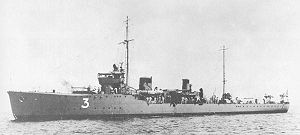- No.1 class minesweeper (1923)
-

No.3 in 1923Class overview Name: No.1 class minesweeper Builders: Sasebo Naval Arsenal
Harima Zōsen
Mitsui Bussan
Ōsaka Iron WorksOperators:  Imperial Japanese Navy
Imperial Japanese NavySucceeded by: No.13-class Subclasses: No.1-class (Project Number I1)
No.5-class (Project Number I2)Cost: 700,000 JPY (in 1920) Built: 1922 – 1929 In commission: 1923 – 1946 Planned: 6 Completed: 6 Lost: 5 Retired: 1 General characteristics No.1-class Displacement: 600 long tons (610 t) standard Length: 76.20 m (250 ft 0 in) overall Beam: 8.03 m (26 ft 4 in) Draught: 2.29 m (7 ft 6 in) Propulsion: 2 × triple expansion stages reciprocating engines
3 × Kampon coal fired boilers
2 shafts, 4,000 shpSpeed: 20.0 knots (23.0 mph; 37.0 km/h) Range: 2,000 nmi (3,700 km) at 10 kn (12 mph; 19 km/h) Complement: 97 Armament: • 2 × 120 mm (4.7 in) L/45 naval guns
• 1 × 76.2 mm (3.00 in) L/40 AA gun
• 18 × depth charges
• 2 × Type 81 depth charge projectors
• 1 × paravane or 50 × Mk.5 naval minesGeneral characteristics No.3-class Displacement: 620 long tons (630 t) standard Length: 77.00 m (252 ft 7 in) overall Beam: 8.25 m (27 ft 1 in) Draught: 2.25 m (7 ft 5 in) Propulsion: 2 × triple expansion stages reciprocating engines
3 × Kampon coal fired boilers
2 shafts, 4,000 shpSpeed: 21.0 knots (24.2 mph; 38.9 km/h) Range: 2,000 nmi (3,700 km) at 14 kn (16 mph; 26 km/h) Complement: 91 Armament: • 2 × 120 mm (4.7 in) L/45 naval guns
• 1 × 76.2 mm (3.00 in) L/40 AA gun
• 18 × depth charges
• 2 × Type 81 depth charge projectors
• 2 × paravanes or 50 × Mk.5 naval minesThe No.1 class minesweeper (第一号型掃海艇, Dai Icih Gō-gata Sōkaitei) was a class of minesweepers of the Imperial Japanese Navy (IJN), serving during 1930s and World War II. 6 vessels were built in 1922-29 under the Eight-eight fleet plan. They have two sub classes, this article handles them collectively.
Contents
Background
- In 1920, the IJN made Eight-eight fleet final plan, and they were going to have eight battleships and eight battle cruisers. However, they did not forget Hatsuse and Yashima in the Russo-Japanese War. The IJN was afraid that their new battleships was lost once again with an enemy's naval mine.
- In the IJN, their destroyers undertook minesweeping operations. However, the IJN gave their destroyers a duty of minelayer. Therefore, they wanted the new minesweeper which could follow their new battleships.
- The IJN demanded that they cleaned a route of the Combined Fleet by the No.1-class. Therefore, they gave No.1-class their destroyer and an equal weapons and 20 kt speed. Furthermore, the IJN more added a minelayer facilities for the No.1-class.
Ships in classes
No.1 class
- Project number I1. 4 vessels were built in 1922-1925. No.4 was behind with the laid down by the Washington Naval Treaty.
Ship Builder Laid down Launched Completed Fate Yamada Bay on 10 August 1945. Decommissioned on 15 September 1945. Battle of Sunda Strait on 1 March 1942. Decommissioned on 30 November 1945. Ōfunato Bay on 9 April 1945. Decommissioned on 10 May 1945. Royal Navy at Singapore on 11 July 1946. Decommissioned on 10 August 1946. No.5 class
- Project number I2. 2 vessels were built in 1928-1929. Improved model of the No.1-class. About their appearance, foremast was changed to tripod type.
Ship Builder Laid down Launched Completed Fate Strait of Malacca 33°44′N 99°50′E / 33.733°N 99.833°E on 4 November 1944. Decommissioned on 10 March 1945. Kuching 01°34′N 110°21′E / 1.567°N 110.35°E on 26 December 1941. Decommissioned on 10 January 1942. Photo
-
No.5 in 1930s (after the Tomozuru-Incident)
Footnotes
- ^ Minesweeper No.1 (第一号掃海艇 Dai 1 Gō Sōkaitei). The same shall apply hereinafter.
- ^ In the neighborhood of spot, many parts of the Type 93 torpedo were discovered. The Japanese destroyers which participated in Battle of Sunda Strait were not equipped with Type 93 torpedo.
Bibliography
- Ships of the World special issue Vol.45, Escort Vessels of the Imperial Japanese Navy, "Kaijinsha". http://www.ships-net.co.jp/., (Japan), February 1996
- The Maru Special, Japanese Naval Vessels No.50, Japanese minesweepers and landing ships, "Ushio Shobō". http://www.kojinsha.co.jp/. (Japan), April 1981
Japanese auxiliary ship classes of World War IICargo ships Colliers and Oilers Ōtomari S
Landing ships No.1 · No.101 · Shinshū Maru S (Army) · SS (Army)
Minelayers and Cable layer Tokiwa SC · Itsukushima S · Yaeyama S · Okinoshima S · Tsugaru S · Minoo SC · Shirataka S · Hatsutaka · Tsubame · Natsushima (1933) · Sokuten (1938) · Hirashima · Ajiro S · Kamishima · Hashima · Sokuten (1913) · Aux. No.1 · Aux. No.101 (ex-HMS Barlight) SC
Minesweepers No.1 (1923) · No.5 (1928) · No.13 · No.17 · No.7 (1938) · No.19 · No.101 (ex-HMS Taitam and Waglan) C · Aux. No.1 · Aux. No.101 (ex-HNLMS DEFG class) · Aux. No.104 (ex-HNLMS DEFG class)
Patrol boats Seaplane tenders Submarine chasers
Survey ships Target ships Training ships Fuji SC · Shikishima SC · Asama SC · Azuma SC · Kasuga SC
S - Single ship of class • C - Converted to ship type • I - Incomplete until the end of war Categories:- World War II naval ships of Japan
- Minesweepers of Japan
- Small combat vessel classes
- 1920s ships
Wikimedia Foundation. 2010.



